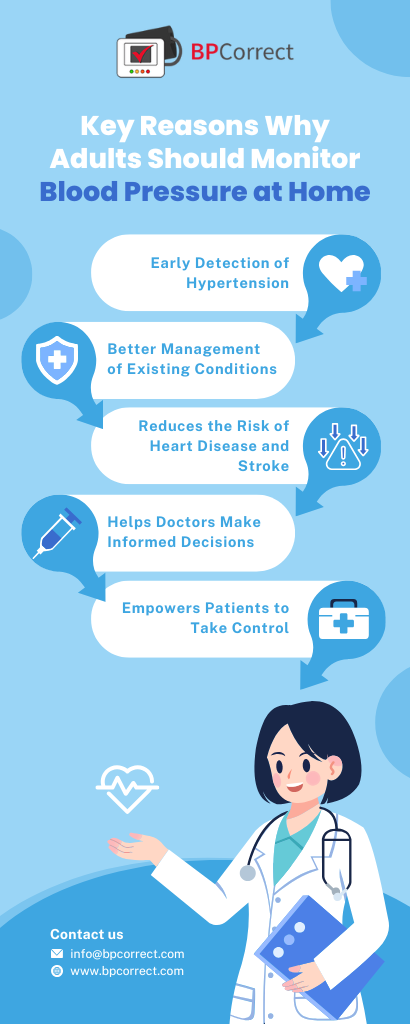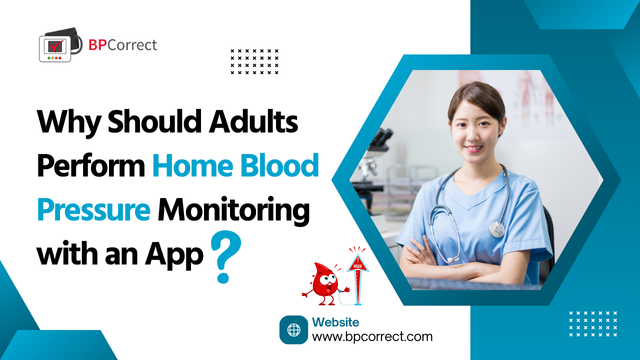High blood pressure, or hypertension, is often called the “silent killer” because it can develop without noticeable symptoms while increasing the risk of severe health conditions like heart disease, stroke, and kidney failure. With modern technology, home blood pressure monitoring has become more accessible and convenient, especially with the use of a blood pressure monitor app. These apps, such as BPCorrect, help individuals track and manage their blood pressure levels efficiently.
In this article, we will explore why adults should perform home blood pressure monitoring, the benefits of using a BP monitoring app for patients, and how apps like BPCorrect can help improve health outcomes.
The Importance of Home Blood Pressure Monitoring
Traditionally, blood pressure monitoring was only done during doctor visits. However, this approach has limitations, including “white coat syndrome,” where patients experience elevated readings due to stress during medical visits. Home blood pressure monitoring allows for more accurate readings in a relaxed environment and provides better insights into an individual’s health trends over time.
Read More: Best Apps for Controlling High Blood Pressure: Track, Manage, and Stay Healthy
Key Reasons Why Adults Should Monitor Blood Pressure at Home

1. Early Detection of Hypertension
Regular monitoring can help detect hypertension early, allowing individuals to take preventive measures before it leads to severe complications.
2. Better Management of Existing Conditions
For individuals already diagnosed with high blood pressure, home monitoring ensures their treatment plan is working effectively.
3.Reduces the Risk of Heart Disease and Stroke
Keeping blood pressure in check reduces the risk of cardiovascular diseases, which are among the leading causes of death globally.
4. Helps Doctors Make Informed Decisions
Having consistent readings from a BP monitoring app for patients helps doctors adjust medications and lifestyle recommendations based on accurate data.
5. Empowers Patients to Take Control
When individuals actively monitor their blood pressure, they become more engaged in their health, leading to better compliance with treatment plans.
The Role of a Blood Pressure Monitor App
With advancements in digital health, many people now use blood pressure monitor apps to track and analyze their readings conveniently. These apps provide a range of features, including:
- Automatic data logging to avoid manual record-keeping.
- Trends and analysis to detect patterns over time.
- Reminders and alerts to ensure regular monitoring.
- Integration with smart devices like digital BP cuffs and fitness trackers.
- Sharing data with healthcare providers for better clinical decision-making.
Why Use BPCorrect for Blood Pressure Monitoring?
BPCorrect is a user-friendly BP monitoring app for patients designed to simplify the tracking and management of blood pressure levels. Here’s why adults should consider using it:
1. Accurate Data Logging
BPCorrect allows users to enter their blood pressure readings manually or sync them with smart BP monitors. It ensures precise record-keeping and reduces the risk of data loss.
2. Graphical Analysis and Trends
The app provides visual graphs and statistical trends, making it easier for users to understand fluctuations in their blood pressure levels over time.
3. Customizable Alerts and Reminders
Many patients forget to check their blood pressure regularly. BPCorrect solves this issue with personalized reminders, ensuring consistency in monitoring.
4. Data Sharing with Doctors
Users can easily share their blood pressure logs with healthcare providers via email or direct app integration. This helps doctors make informed decisions based on long-term trends rather than single-visit readings.
5. Lifestyle and Health Tips
In addition to tracking blood pressure, BPCorrect provides personalized health tips, including diet recommendations, exercise suggestions, and stress management techniques.
6. Secure and User-Friendly Interface
The app is designed with simplicity in mind, making it accessible even for older adults who may not be tech-savvy.
Read More: How to Measure Blood Pressure at Home Accurately?
How to Use a BP Monitoring App Effectively
Using a BP monitoring app for patients correctly can enhance its benefits. Here are some best practices:
1. Measure Blood Pressure at the Right Time
- Avoid checking blood pressure right after exercise or consuming caffeine.
- Take readings at the same time each day for consistency.
2. Follow the Correct Measurement Technique
-
- Sit in a relaxed position with your back supported.
- Keep your arm at heart level while measuring.
- Take multiple readings and use the average for accuracy.
3. Record Additional Health Information
-
- Many apps, including BPCorrect, allow users to add notes about their diet, stress levels, and medications, providing a more comprehensive health overview.
4. Regularly Review Trends
-
- Keep track of long-term patterns and share them with your healthcare provider.
The Benefits of Digital Health in Hypertension Management
Home monitoring, combined with blood pressure monitor apps, represents a shift toward digital health solutions. Some benefits include:
- Improved Adherence: Patients are more likely to track their health regularly when they have an easy-to-use app.
- Reduced Healthcare Costs: Preventing hypertension complications can save money on medical bills and hospitalizations.
- Better Chronic Disease Management: Digital health tools make managing conditions like hypertension more efficient and effective.
Conclusion
Managing blood pressure at home using a blood pressure monitor app like BPCorrect offers numerous advantages, including early detection, better management of hypertension, and improved patient engagement. A BP monitoring app for patients ensures accurate tracking, provides valuable health insights, and helps doctors make informed decisions.
By incorporating home monitoring into daily routines, adults can take charge of their health and significantly reduce the risk of serious complications associated with high blood pressure. If you haven’t started yet, now is the perfect time to download BPCorrect and take control of your heart health today!



